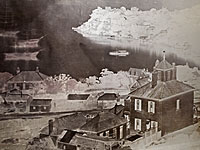
 This
is the largest wet plate negative in the world, one of four made in 1875 by
Charles Bayliss and Bernard Holtermann from a tower above Holtermann’s house in
North Sydney. It is a view of the city across Lavender Bay.
This
is the largest wet plate negative in the world, one of four made in 1875 by
Charles Bayliss and Bernard Holtermann from a tower above Holtermann’s house in
North Sydney. It is a view of the city across Lavender Bay.
For much of the nineteenth century, it was not possible to make photographic enlargements, so big photographs were printed from correspondingly large negatives. In this case, the ‘camera’ was actually a room 3 x 4 metres, with a huge lens replacing the window, allowing Bayliss and Holtermann to walk about and manipulate the glass negative from inside.
In the wet plate process, the negative was coated in the dark with a sticky collodion solution containing silver salts, and exposed and developed while still wet. If allowed to dry out, the emulsion no longer retained its light sensitivity. To complicate matters, the plates had to be manhandled 27 metres down from the tower to a room for processing. Each plate weighed around 23 kilograms, so the task was not easy.
Holtermann had been involved in the discovery of the world’s largest specimen of
reef gold at Tambaroora, New South Wales, in 1872. He used his wealth to promote
Australia overseas and exhibited prints from these mammoth negatives at the
Philadelphia Centennial Exhibition of 1876 and at the Paris Exposition
Universelle Internationale in 1878.
Display item Sydney from North Shore, 1875
< Previous Exhibit | Back to The Exhibits page | Next Exhibit >